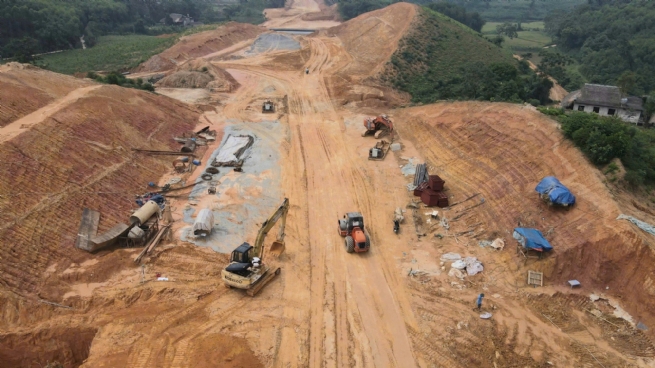Slow Progress in Public Investment Disbursement
Public investment remains a cornerstone of Vietnam’s strategy for economic recovery and growth, especially in national infrastructure projects and strategic economic zones. Yet sluggish disbursement continues to be a critical bottleneck, hindering investment efficiency and slowing economic development.
Rapid implementation, high efficiency
The 500kV transmission line (third circuit) from Quang Trach in Quang Tri Province to Pho Noi in Hung Yen Province extends over 500 km with a total investment of nearly VND3 trillion. Under the direct supervision of the Prime Minister, the project was completed and handed over for operation in just seven months of construction. This set a record compared with similar-scale projects, which previously took about four years. Despite spanning multiple provinces with varying land clearance and compensation policies, the project was finished on schedule, ensuring both cost savings and quality.

Public investment is the cornerstone of Vietnam’s economic recovery and growth strategy
Another example is the Phong Chau Bridge in Phu Tho Province. Implemented through an emergency government capital allocation and directly awarded to Army Corps 12, the bridge was completed in just 10 months and put into use. These two projects vividly demonstrate the effectiveness of public investment when decisive government leadership is paired with close coordination between local authorities and contractors. Record completion times, cost savings, and guaranteed quality show that, when well-organized, public investment can deliver infrastructure breakthroughs, foster economic and social development, and reinforce national energy security and strategic transportation networks.
Dr. Nguyen Duc Kien, former member of National Assembly and former Head of the Prime Minister’s Economic Advisory Group, emphasized that these successes reveal a deeper issue: “State management agencies and public opinion often overlook real investment efficiency, focusing instead on procedures and processes of our own making, enshrined in regulations issued by the National Assembly and the Government.”
According to him, in the new era, if Vietnam wants rapid growth of around 10% annually, it must rethink its approach to public investment. The priority should be on efficiency and nurturing Vietnamese enterprises capable of regional and global expansion, while avoiding outdated procedures that, under the guise of quality control and market equality, actually constrain economic growth.
In particular, he stressed that to accelerate Vietnam’s railway mega-project, by 2025 the Government must directly award infrastructure contracts, negotiate licenses for locomotive, carriage, and signaling production, and ensure work begins no later than December for completion during the 2026-2030 period.
Raising disbursement levels in the coming months
According to the Ministry of Finance, by the end of September 2025, total public investment disbursement was estimated at VND440,402.3 billion, equivalent to about 50% of the plan assigned by the Prime Minister. Nine central ministries and agencies, together with 17 localities, recorded disbursement rates at or above the national average.
These include the Vietnam Development Bank, Vietnam Bank for Social Policies, Vietnam General Confederation of Labor, Office of the Party Central Committee, Voice of Vietnam (VOV), Vietnam Electricity (EVN), Ministry of National Defense, Vietnam Expressway Corporation (VEC), and the Vietnam Women’s Union. The provinces and cities are Ha Tinh, Thanh Hoa, Ninh Binh, Lao Cai, Thai Nguyen, Phu Tho, Bac Ninh, Gia Lai, Hai Phong, Tay Ninh, Nghe An, Quang Ngai, Dien Bien, Thua Thien Hue, Quang Ninh, Lang Son, and Dong Thap.
Remarkably, despite disruptions from the transition to the two-tier local government model and severe weather conditions in the North Central and northern mountainous regions, some localities still maintained disbursement rates above 60% of the assigned plan, including Ha Tinh (110%), Thanh Hoa (92%), and Ninh Binh (91%).
To achieve full disbursement of the 2025 plan and support GDP growth of 8.3-8.5%, the Ministry of Finance has urged other ministries, sectors, and localities to rigorously implement Resolution 273/NQ-CP (September 9, 2025) of the Government, as well as Prime Minister’s Directives 162/CD-TTg (September 11, 2025) and 169/CD-TTg (September 21, 2025).
The ministry emphasized the need for all units to learn from past shortcomings and execute comprehensive solutions to accelerate disbursement in the final months of the year, including quickly consolidating organizational structures, stabilizing personnel, and assigning qualified staff in two-tier local government units to manage and implement projects, especially in remote and disadvantaged areas; delegating project ownership to commune-level authorities with resources and capacity aligned to implementation; and ensuring close inter-ministerial coordination to resolve obstacles in decentralization, authority, and management of public investment under the two-tier model.
On mechanisms and policies, the Ministry of Finance proposed that the Government instruct the Ministry of Agriculture and Environment to urgently submit a resolution addressing issues related to the implementation of the 2024 Land Law in urgent public investment projects and projects serving APEC meetings.
On execution, units must assign responsible officers to each project, prepare detailed disbursement schedules by week, month, and quarter, and closely monitor progress. Priority must also be given to land clearance, timely removal of land and resource bottlenecks, and ensuring stable supplies of construction materials.
For project acceptance and payments, contractors must immediately submit payment dossiers for completed, certified work volumes to avoid end-of-year bottlenecks.
For national key projects, particularly in transport infrastructure, the Ministry of Finance has requested the Ministry of Construction and localities to instruct contractors and investors to recover delayed schedules, targeting the completion of at least 3,000 km of expressways, over 1,000 km of coastal roads, and major works such as Long Thanh International Airport within 2025. Preparations must also be accelerated for critical railway projects, including the North-South express railway and the Vietnam-China connection railway lines.








